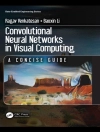Infrastructure for Homeland Security Environments
Wireless Sensor Networks helps readers discover the emerging field
of low-cost standards-based sensors that promise a high order of
spatial and temporal resolution and accuracy in an ever-increasing
universe of applications. It shares the latest advances in science
and engineering paving the way towards a large plethora of new
applications in such areas as infrastructure protection and
security, healthcare, energy, food safety, RFID, Zig Bee, and
processing.
Unlike other books on wireless sensor networks that focus on
limited topics in the field, this book is a broad introduction that
covers all the major technology, standards, and application topics.
It contains everything readers need to know to enter this
burgeoning field, including current applications and promising
research and development; communication and networking protocols;
middleware architecture for wireless sensor networks; and security
and management.
The straightforward and engaging writing style of this book makes
even complex concepts and processes easy to follow and understand.
In addition, it offers several features that help readers grasp the
material and then apply their knowledge in designing their own
wireless sensor network systems:
* Examples illustrate how concepts are applied to the development and
application of
* wireless sensor networks
* Detailed case studies set forth all the steps of design and
implementation needed to solve real-world problems
* Chapter conclusions that serve as an excellent review by stressing
the chapter’s key concepts
* References in each chapter guide readers to in-depth discussions of
individual topics
This book is ideal for networking designers and engineers who want
to fully exploit this new technology and for government employees
who are concerned about homeland security. With its examples, it is
appropriate for use as a coursebook for upper-level undergraduates
and graduate students.
Inhaltsverzeichnis
Chapter 1. Introduction and Overview of Wireless Sensor Networks.
Chapter 2. Commercial and Scientific Applications of Wireless Sensor Networks.
Chapter 3. Basic Wireless Sensor Technology.
Chapter 4. Wireless Sensors Networks Protocols: Physical Layer.
Chapter 5. Medium Access Control Protocols for Wireless Sensor Networks.
Chapter 6. Sensors Network Protocols: Routing Protocols.
Chapter 7. Transport Control Protocols for Wireless Sensors Networks.
Chapter 8. Middleware for Sensor Networks.
Chapter 9. Network Management for Wireless Sensor Networks.
Chapter 10. Operating Systems for Sensor Networks.
Chapter 11. Performance and Traffic Management Issues.
Appendix A: Analysis.
Appendix B: Discussions.
Index.
Über den Autor
Kazem Sohraby, Ph D, is Professor of Electrical Engineering
in the College of Engineering at the University of Arkansas. Dr.
Sohraby has also served as head of the university’s Department of
Computer Science and Computer Engineering, and as Director of
Telecommunications Management Department at Stevens Institute of
Technology, Hoboken, New Jersey. Prior to his university
appointment, Dr. Sohraby spent much of his career at Bell Labs
Advanced Communication Technologies Center. His work resulted in
more than twenty new patents for Bell Labs.
Daniel Minoli has worked and published extensively in the
field of IT security, with more than thirty years of hands-on
experience in IT, telecommunications, wireless, and networking. He
has helped develop systems and solutions for such organizations as
Advanced Research Projects Agency (ARPA) think tanks, Bell
Telephone Laboratories, ITT, Prudential Securities, Telcordia (Bell
Communications Research), AT&T, Leading Edge Networks, Capital
One Financial, SES Americom, New York University, Rutgers
University, Stevens Institute of Technology, and Société
Générale de Financement du Québec. His columns have
been published in Computerworld, Network World, and Network
Computing.
Taieb Znati, Ph D, is a Professor in the Department of
Computer Science at the University of Pittsburgh. Dr. Znati’s
recent work focuses on the design and analysis of network protocols
for wired and wireless communications, sensor networks, network
security, agent-based technology with collaborative environments,
and middleware.












